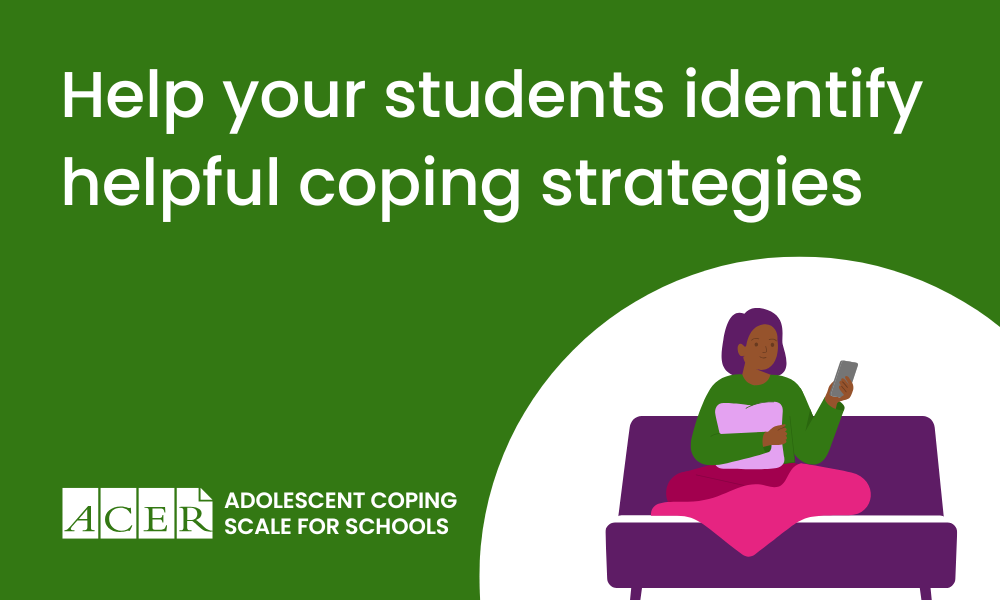Adolescence is a period of rapid development. During this time, students face challenges in their learning and emotional growth, undergo physiological changes, experience shifts in peer relationships and begin to develop personal agency and independence. All of these can lead to increased stress. To support students through these challenges, educators need effective tools to help them understand how they’re coping – and how they can do so more effectively.
What is the Adolescent Coping Scale for Schools?
Developed by Dr Erica Frydenberg and Professor Ramon Lewis and first published in 1993 by the Australian Council for Educational Research (ACER), the Adolescent Coping Scale for Schools (ASC-S) is grounded in decades of research. Adapted explicitly for a school context in 2024, it is an important educational resource designed to support young people in examining their own coping strategies.
In the Australian Curriculum, social-emotional learning (SEL) is embedded through Personal and Social Capability, where students learn to understand themselves and others, manage their relationships, lives, work and learning effectively: ‘We want to see students develop self-awareness, self-control and interpersonal skills that are important for schoolwork and life outcomes.’
About the questionnaire
The self-paced online questionnaire includes 60 self-assessment items designed to support young people in identifying their coping behaviours and develop problem-solving strategies to manage difficult situations productively.
Students are asked to rate the frequency and helpfulness of 20 evidence-based coping strategies. Each of the 20 strategies has 3 items. Students can choose between focusing on general coping concerns or on a specific coping concern that they have identified as they move through the questions.
The questionnaire groups these into 3 broad categories:
- Productive coping strategies, such as solving problems, seeking social support, engaging in physical activity and working towards goals
- Non-productive coping strategies, such as worry, withdrawal, self-blame, ignoring problems and wishful thinking
- Other coping styles, including humour and seeking spiritual support.
The questionnaire produces a personalised coping profile that not only informs teachers of what coping strategies are being utilised, but also how frequently.
Teachers can use the report to start conversations, design interventions or support SEL in the classroom. For students themselves, it helps to identify how they cope, and improve resilience.
What the research shows
Coping is about self-assessment, reflection and subsequent skill development that builds on the social and cultural contexts in which adolescents find themselves (Frydenberg & Lewis, 1993).
A 5-year longitudinal study tracked 168 students from years 7–11, providing insight into how coping strategies evolve during adolescence. Key findings included:
- Between the ages of 12 and 14, both boys and girls remained relatively stable in their inability to cope. The leading factor in this interpretation was the big transition between primary school to high school
- Girls reported increased difficulty coping by age 16, while boys showed improved coping capacity
- Five of the coping strategies (social support, solving the problem, self-blame, keep to self and tension reduction) increased with age
- Self-blame and social support usage diminished in boys from age 12-14 but increased back to age 12 levels by the time they were 16
- For girls, these 2 strategies increased moderately between 12 and 14, but dramatically between 14 and 16
- Encouragingly, students became more open to seeking professional help by the later high school years
We can see that boys and girls develop differently in their patterns of coping across the ages. This research also reinforces the importance of timing and targeted support. With early identification, schools can help students shift toward more productive coping strategies and build stronger, healthier responses to stress.
Why it matters for schools
ASC-S is more than just a diagnostic tool – it is a starting point for student wellbeing initiatives. When used effectively, it can:
- serve as a universal screening tool for student wellbeing
- provide data before and after implementing SEL programs
- support small-group discussions or classroom conversations
- help students recognise unhelpful patterns and replace them with healthier alternatives.
Crucially, the questionnaire is designed to help students assess their own coping strategies – the behaviours, thoughts and actions they use to handle stress or solve problems. It encourages reflection, promotes emotional self-awareness and helps them (and teachers) recognise what’s working and what’s not.
In identifying existing coping strategies, teachers can help students build a bank of personalised coping strategies, so they have these to draw on to navigate changes and challenges successfully.
Resources
A range of coping resources and questionnaires are available for schools, adapted for different audiences. The ACS-S questionnaire can be supported by additional teaching resources, such as ‘The Best of Coping’ program and student books with activities. Schools can choose to use the questionnaire in a range of settings – from health and wellbeing classes to pastoral care and student support services.
Find more information here.
References
Frydenberg, E., & Lewis, R. (1993). Adolescent coping scale: Administrator's manual. Australian Council for Educational Research.

